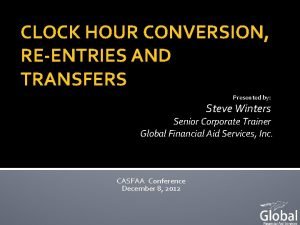Stuttering Marquis Harper 5 th Hour Intro Stuttering






- Slides: 6

Stuttering Marquis Harper 5 th Hour

Intro Stuttering can be described as a disturbance in the flow or rhythm of connected speech. It is usually characterized by repetitions of syllables and occasional cessation of airflow (i. e. , air ceases to flow through the vocal folds and the vocal folds cease vibrating; thus, no sound is produced). In advanced cases of stuttering certain secondary phenomena occur. Extreme tension in the musculature of the vocal folds, tongue, lips and face cause "struggle behavior" tics, head jerks, etc. Most stutterers develop fear of certain words or speaking situations as well, and try to avoid these

Symptoms of stuttered speech often includes repetitions of words or parts of words, as well as prolongations of speech sounds. These disfluencies occur more often in persons who stutter than they do in the general population. Some people who stutter appear very tense or "out of breath" when talking. Speech may become completely stopped or blocked. Blocked is when the mouth is positioned to say a sound, sometimes for several seconds, with little or no sound forthcoming.

Causes What causes stuttering? Although the precise mechanisms are not understood, there are two types of stuttering that are more common. (A third type of stuttering, called psychogenic stuttering, can be caused by emotional trauma or problems with thought or reasoning. At one time, all stuttering was believed to be psychogenic, but today we know that psychogenic stuttering is rare. ) Developmental stuttering occurs in young children while they are still learning speech and language skills. It is the most common form of stuttering. Some scientists and clinicians believe that developmental stuttering occurs when children’s speech and language abilities are unable to meet the child’s verbal demands. Developmental stuttering also runs in families. In 2010, for the first time, NIDCD researchers isolated three genes that cause stuttering. More information on the genetics of stuttering can be found in the research section of this fact sheet. Neurogenic stuttering may occur after a stroke, head trauma, or other type of brain injury. With neurogenic stuttering, the brain has difficulty coordinating the different components involved in speaking because of signaling problems between the brain and nerves or muscles.

Prognosis & Treatments In young children about 40% of stuttering cases are cured. In Adults it is very rare for them to stop stuttering. Provide a relaxed home environment that allows many opportunities for the child to speak. This includes setting aside time to talk to one another, especially when the child is excited and has a lot to say. Refrain from reacting negatively when the child stutters. Instead, parents should react to the stuttering as they would any other difficulty the child may experience in life. This may involve gentle corrections of the child’s stuttering and praise for the child’s fluent speech. Speak in a slightly slowed and relaxed manner. This can help reduce time pressures the child may be experiencing. Listen attentively when the child speaks and wait for him or her to say the intended word. Don't try to complete the child’s sentences. Also, help the child learn that a person can communicate successfully even when stuttering occurs. Talk openly and honestly to the child about stuttering if he or she brings up the subject. Let the child know that it is okay for some disruptions to occur.

Resources http: //www. mnsu. edu/comdis/kuster/pioneers/bryngelso n/bryngprognhttp: // www. mayoclinic. org/diseasesconditions/stuttering/basics/causes/CON 20032854 osis. html http: //www. stutteringhelp. org/neuralbases-stuttering-and-its-treatment











